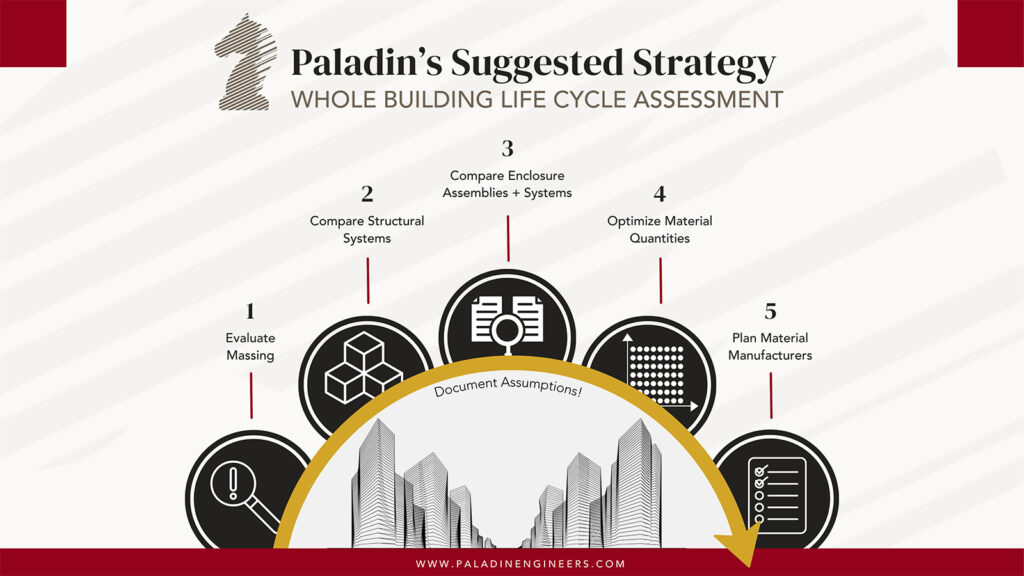By Candice Rogers, Paladin, Inc.
Back in the day of paper maps, planning a trip to a new jobsite involved a Rand McNally atlas or printed Mapquest directions and an ability to actually read road signs. Too often, those trips became a series of missed turns, late arrivals, and close calls as drivers navigated highways and byways with maps in their laps. With today’s technology, Google Maps and Waze are taking the guess work out of jobsite preparations, plotting a path to the next destination and offering a helpful “Recalculating” should the navigator miss his or her exit.
That situation is echoed in the world of commercial buildings as environmental laws and regulations evolve, leaving building owners with their own set of questions about the best route to measuring embodied carbon. Fortunately for them, new technology and methods like the WBLCA are helping them provide incredibly accurate answers to those questions as they map a pathway to success.

UNDERSTANDING WBLCAs
Whole Building Life Cycle Assessments (WBLCAs) are an invaluable tool in design for today’s built environment. As all engage in optimizing for embodied carbon reductions whether through Owner pledges or AIA 2030 Challenge, the WBLCA leverages detailed data to help all involved navigate the design decision making process to best effect.
Even though the process is well documented, I am often met with questions about “Who does what and when?” As with many big questions, the answer is dependent upon variables. However, understanding the drivers and the process allows a team to think through the opportunities that exist for each unique project.
Let’s begin with an understanding of what a WBLCA measures. The WBLCA is built off an inventory of Environmental Product Declarations which can encompass every building material from mud mats and rebar to carpet and paint. An Environmental Product Declaration for each commodity type “transparently reports objective, comparable and third-party verified data about products environmental performances from a lifecycle perspective” (Cite: www.environdec.com/all-about-epds/the-epd).
Therefore, a WBLCA is an accumulation of individual material lifecycle assessments measuring everything from how and where its raw materials were extracted to the pollution generated by transportation to the environmental cost of disposal. When aggregated, those individual ratings combine to form the final score. A valuable exercise is to brainstorm the difference in materials types – e.g. concrete versus steel versus wood. When that exercise is completed, you can start to see why certain materials are environmentally preferrable.
A CULTURE OF TRANSPARENCY
Given the complexity of a typical building project and the variety of options when it comes to design and materials, the best carbon reductions will flow from a culture of honest dialogue and consistent discipline.
The baseline for making improvements is the willingness to cast a critical eye on every aspect of the initial design concept. With that understanding, the WBLCA comparisons completed on a project (which provide the basis for those statistics related to emissions saved) are driven by comparing functionally equivalent buildings. Building class, square footage, location, and other similar design parameters are typically the constants between the two.
For improvements, the design team can begin evaluation of massing considerations, foundation options, alternatives for wall assembly structures, and so forth. When these options are defined as a team, one can start with the apples-to-apples comparisons that lead to reasonable change. When these comparisons occur earlier in the design phase, bigger, more impactful changes can be made on the fundamental elements of a project.
SYSTEM EVALUATIONS
The next stage of improvements looks at system evaluations. When working with a multidisciplinary team, we strongly encourage them to evaluate the planned building enclosure assemblies and determine the quantities and ratios of material types like brick, precast, metal panel, or other materials. A willingness to increase, decrease or alter the use of materials based on their environmental impact can help the project retain the desired architectural language while making inroads on the building’s embodied carbon.
After addressing the big items like structural elements and wall assemblies, it’s time to extend this “environmental economizing” mindset into decision making on all materials on the project because each has their own “footprint” based on their source, their manufacturing, etc. So, winnowing down the carbon signature of each commodity (brick, steel, etc.) by ranking the specific emissions characteristics of options from different manufacturers, one can develop highly detailed materials requirements that accelerate progress toward the best possible score.
NO BAD MATERIALS
In this deliberative process, there is no such thing as a “bad” material, just choices along a continuum. While there are compelling aesthetic reasons for using certain materials, each has a carbon “weight” or “signature” that can support the case for using them sparingly. Take roofing systems, for example. A owner-directed roof type may be less environmentally friendly than other options, so the WBLCA can be used to facilitate a data-based conversation on the requirement and present potential alternatives alongside their pros and cons. Should the owner decide to remain with the mandated roofing system, the design team now can use the WBLCA data to identify areas where the building can offset environmental impacts of the roofing requirement.
At the end of the day, designing for embodied carbon reduction requires a clear-eyed assessment of reality, the willingness to make some tough choices and a decision to get started sooner than later with insight from experts. When the design team maintains open lines of communication, leverages the best available data and stays focused on the end goal, the outcomes can be truly worth the work.
To learn more about WBLCAs and the best practices on the path to achievement, contact Paladin, Inc.
